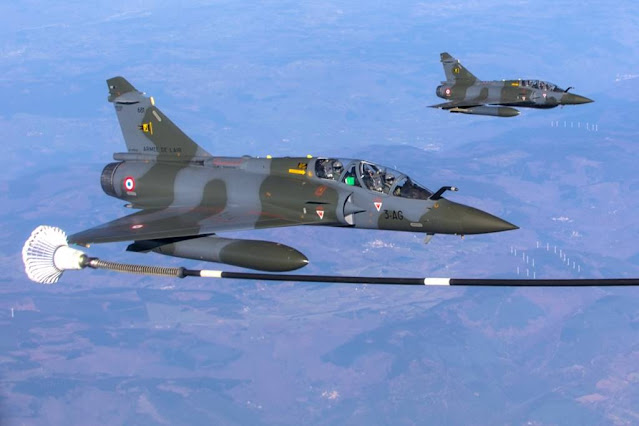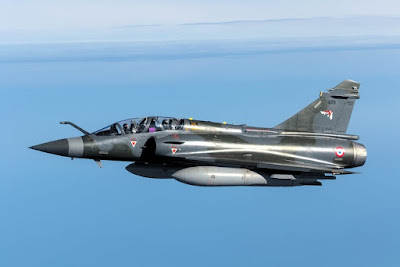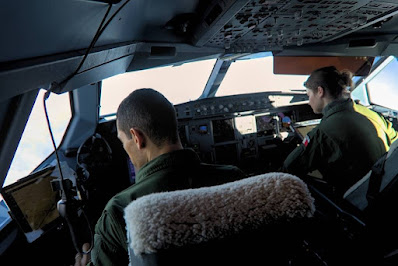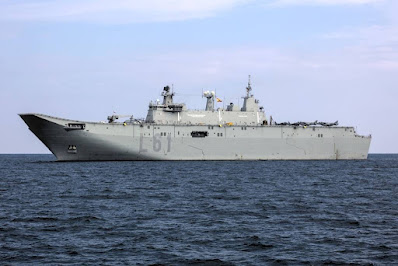Orion 23: France's biggest military exercise in decades
 |
| French Air Force Mirage 2000D combat aircraft receive fuel from an A330 MRTT tanker during exercise Orion 23. |
The ORION 2023 exercise (an acronym for large-scale Operation for Resilient, Interoperable, high-intensity combat-Oriented and INnovative armed forces) is a new triennial military exercise cycle. ORION is the first exercise of its kind in 2023, it kicked off in late February and will run until mid-March.
French armed forces are adapting their operational readiness accordingly.
The objective is to train French armed forces in a joint and combined framework, based on a realistic and demanding scenario that takes into consideration the multiple domains of conventional (land, air sea, space) and hybrid warfare (influence, cyber, electronic). ORION 23 aims to:
● refocus French military training on readiness to any type of event through large-scale multi-domain operations;
● assess France’s ability to conduct a large-scale joint operation;
● reinforce interoperability with our allies;
● test new capabilities.
During the the entry mission, some 7000 troops will exercise for 19 days in southern France, south of the city of Montpellier. An amphibious group (consisting of the amphibious carriers PHA Tonnerre and the PHA Mistral) would bring the one amphibious component (6th Light Armored Brigade) to the shores of France. While one airborne component (11th Parachute Brigade) would be airdropped near the village of Castres. Both the amphibious and airborne components of the French Army would join up to establish a firm beachhead.
The French Navy protected the entry mission with the carrier air wing of the aircraft carrier PA Charles de Gaulle). And the Air Force would protect and support the entry mission with some 30 aircraft (fighters, tankers and transport aircraft).
SCENARIOS
ORION 23 is based on a scenario developed by NATO to study the various phases of a modern conflict. Although the narrative is fictitious, the exercise remains credible. The scenario enables all the components of a military force (land, air, navy, cyber, etc.) to work together as a coordinated team and to achieve the various training objectives. The intensity of the exercise further reinforces its realism. For example, the exercise will include the participation of a sizeable adversary force (FORAD), armed by French and allied units.
IN THE AIR
On March 01, 2023, a media flight was organized in a French Airbus A330 MRTT tanker aircraft from the French Air Force (Armée de l'Air et de l'Espace, AAE) . From Base Aérienne 125 ‘Istres-Le Tubé’ "Charles Monier" (ICAO code: LFMI) a media flight in an A330 MRTT (Multi Role Transport Tanker) was planned. The A330 MRTT with registration 049/F-UJCO belongs to the 31 EARTS squadron (31e Escadre Aérienne de Ravitaillement et de Transport Stratégiques). Currently nine A330 MRTT aircraft have been delivered to the French Air Force, while a total of twelve aircraft are planned to be delivered by the end of this year. A grand total of 15 A330 MRTT aircraft will be used by the French Air Force for the next decades.
The predecessor of the A330 MRTT in the French Air Force is the Boeing C-135F/KC-135, currently 6 C-135s are still active, while the remaining 9 aircraft are stored at Aéroport de Nîmes-Alés-Camargue-Cévennes.
Commandant Mohammed (due to security reasons, only first names) did the preflight checks before take-off, checking tires, engines, vision and refueling equipment. After take-off from Base Aérienne ‘Istres-Le Tubé’ , the A330 flew some 175 kilometers to the JUDITH refueling area, north of Perpignan. After establishing in the JUDITH track, it was circling for the receivers and after a while four Dassault Rafales B from Base Aérienne 113 ‘Saint-Dizier-Robinson’, (ICAO: LFSI) arrived for refueling. The Rafales used the hose-drogue refueling system mounted on the wings of the A330 and as the capacity of the hose-drogue system is lower than the tail-mounted boom refueling system, the Rafales stayed for a while refueling. The aircraft lined up on the left side of the tanker and started the refueling on the 2 wings simultaneously. After refueling, the aircraft lined up on the right side and they flew away for their task in the ORION exercise.
Next for refueling came four Mirage 2000Ds from Base Aérienne 133 ‘Nancy-Ochey’ (ICAO: LFSO). The same procedure was followed for refueling the four aircraft, moving from the left side to the right side.
During a pause in the refueling, the cockpit could be visited while a C-135F was flying a couple of hundred feet higher. Plane commandant Mohammed told about this very large training ORION and about the fuel receivers of the mission.
After the pause, the four Mirage 2000Ds returned for second refueling, after attacking their ground targets of this ORION mission, to refuel for their flight back home. As a grand finale, one Mirage 2000D made a nice barrel roll diving towards the ground (this was announced).
The mission was finished and the A330 landed at BA Istres again.
During the ORION phase 2, the tanker aircraft of BA Istres flew 2 missions per day, for both types C-135F and A330 MRTT; while some 30 aircraft were refueled.
SCENARIOS
ORION 23 is based on a scenario developed by NATO to study the various phases of a modern conflict. Although the narrative is fictitious, the exercise remains credible. The scenario enables all the components of a military force (land, air, navy, cyber, etc.) to work together as a coordinated team and to achieve the various training objectives. The intensity of the exercise further reinforces its realism. For example, the exercise will include the participation of a sizeable adversary force (FORAD), armed by French and allied units.
IN THE AIR
On March 01, 2023, a media flight was organized in a French Airbus A330 MRTT tanker aircraft from the French Air Force (Armée de l'Air et de l'Espace, AAE) . From Base Aérienne 125 ‘Istres-Le Tubé’ "Charles Monier" (ICAO code: LFMI) a media flight in an A330 MRTT (Multi Role Transport Tanker) was planned. The A330 MRTT with registration 049/F-UJCO belongs to the 31 EARTS squadron (31e Escadre Aérienne de Ravitaillement et de Transport Stratégiques). Currently nine A330 MRTT aircraft have been delivered to the French Air Force, while a total of twelve aircraft are planned to be delivered by the end of this year. A grand total of 15 A330 MRTT aircraft will be used by the French Air Force for the next decades.
The predecessor of the A330 MRTT in the French Air Force is the Boeing C-135F/KC-135, currently 6 C-135s are still active, while the remaining 9 aircraft are stored at Aéroport de Nîmes-Alés-Camargue-Cévennes.
Commandant Mohammed (due to security reasons, only first names) did the preflight checks before take-off, checking tires, engines, vision and refueling equipment. After take-off from Base Aérienne ‘Istres-Le Tubé’ , the A330 flew some 175 kilometers to the JUDITH refueling area, north of Perpignan. After establishing in the JUDITH track, it was circling for the receivers and after a while four Dassault Rafales B from Base Aérienne 113 ‘Saint-Dizier-Robinson’, (ICAO: LFSI) arrived for refueling. The Rafales used the hose-drogue refueling system mounted on the wings of the A330 and as the capacity of the hose-drogue system is lower than the tail-mounted boom refueling system, the Rafales stayed for a while refueling. The aircraft lined up on the left side of the tanker and started the refueling on the 2 wings simultaneously. After refueling, the aircraft lined up on the right side and they flew away for their task in the ORION exercise.
Next for refueling came four Mirage 2000Ds from Base Aérienne 133 ‘Nancy-Ochey’ (ICAO: LFSO). The same procedure was followed for refueling the four aircraft, moving from the left side to the right side.
During a pause in the refueling, the cockpit could be visited while a C-135F was flying a couple of hundred feet higher. Plane commandant Mohammed told about this very large training ORION and about the fuel receivers of the mission.
After the pause, the four Mirage 2000Ds returned for second refueling, after attacking their ground targets of this ORION mission, to refuel for their flight back home. As a grand finale, one Mirage 2000D made a nice barrel roll diving towards the ground (this was announced).
The mission was finished and the A330 landed at BA Istres again.
During the ORION phase 2, the tanker aircraft of BA Istres flew 2 missions per day, for both types C-135F and A330 MRTT; while some 30 aircraft were refueled.
ON THE GROUND
On March 02, 2023, a media visit was organized to the command post of the 6th light armored brigade, located in Sète, near Montpellier in southern France. The location was an abandoned factory where the command post was set up. In one of the halls, a scaled model of the area was laid-out on the floor.
AT SEA
On March 02, 2023, a media visit was organized to the amphibious helicopter carrier PHA Tonnerre (L9014) of the French Navy (Marine Nationale, MN), anchored close to Sète, near Montpellier in southern France.
With the landingcraft, the trip from the port of Sète was made to the PHA Tonnerre. During this trip, the ships that participated in the exercise and were moored at sea could be seen. Present at sea were several NATO frigates and 3 amphibious carriers: PHA Tonnerre, PHA Mistral, Juan Carlos 1
On board of the PHA Tonnerre, a press conference was given by capitaine de frégate Juste (deputy commander of the embarked staff, French Navy) and lieutenant-colonel Sébastien (chief of staff of the embarked staff, French Army). They explained the first part of the exercise, whereby the 2 amphibious helicopter carriers sailed from Corsica towards the southern part of France, under cover of the ‘Charles de Gaulle’ battlegroup that sailed from Italy towards Sardinia. During the second phase, both helicopter carriers were located near the coast of France offloading the troops and equipment, with the ‘Charles de Gaulle’ battlegroup taking up a protective position near Spain. In this phase, the opposing forces, by means of the Juan Carlos battle group, positioned themselves between Italy, Corsica and Sardina to attack the amphibious carriers.
At the end, a small helicopter flight in an Army NH90 helicopter was organized to fly overhead of the PHA Tonnerre and the PHA Mistral.
On March 02, 2023, a media visit was organized to the amphibious helicopter carrier PHA Tonnerre (L9014) of the French Navy (Marine Nationale, MN), anchored close to Sète, near Montpellier in southern France.
With the landingcraft, the trip from the port of Sète was made to the PHA Tonnerre. During this trip, the ships that participated in the exercise and were moored at sea could be seen. Present at sea were several NATO frigates and 3 amphibious carriers: PHA Tonnerre, PHA Mistral, Juan Carlos 1
On board of the PHA Tonnerre, a press conference was given by capitaine de frégate Juste (deputy commander of the embarked staff, French Navy) and lieutenant-colonel Sébastien (chief of staff of the embarked staff, French Army). They explained the first part of the exercise, whereby the 2 amphibious helicopter carriers sailed from Corsica towards the southern part of France, under cover of the ‘Charles de Gaulle’ battlegroup that sailed from Italy towards Sardinia. During the second phase, both helicopter carriers were located near the coast of France offloading the troops and equipment, with the ‘Charles de Gaulle’ battlegroup taking up a protective position near Spain. In this phase, the opposing forces, by means of the Juan Carlos battle group, positioned themselves between Italy, Corsica and Sardina to attack the amphibious carriers.
At the end, a small helicopter flight in an Army NH90 helicopter was organized to fly overhead of the PHA Tonnerre and the PHA Mistral.
Report: Joris van Boven and Alex van Noije
Text: Joris van Boven and Alex van Noije
Photos: Joris van Boven, Fred Schellens, O. Pierru/armée de Terre/Défense (photos of the air landing at Castres)
Text: Joris van Boven and Alex van Noije
Photos: Joris van Boven, Fred Schellens, O. Pierru/armée de Terre/Défense (photos of the air landing at Castres)














No comments
All comments related to the contents of our articles are welcome. It is not allowed to post promotional messages, links to external sites, or references to activities not related to this blog.